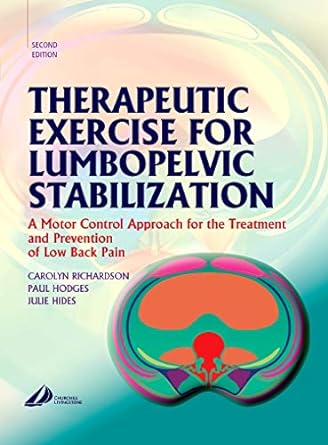Therapeutic Exercise for Lumbopelvic Stabilization: A Motor Control Approach for the Treatment and Prevention of Low Back Pain 2ed
This book is based on the evidence from research undertaken by the authors over a number of years. The significance of these findings to the treatment and prevention of low back pain are now widely acknowledged, not only among researchers but also, and perhaps more importantly, among practitioners concerned with the management and prevention of back pain.
Therapeutic Exercise for Lumbopelvic Stabilization: A Motor Control Approach for the Treatment and Prevention of Low Back Pain 2ed
This book is based on the evidence from research undertaken by the authors over a number of years. The significance of these findings to the treatment and prevention of low back pain are now widely acknowledged, not only among researchers but also, and perhaps more importantly, among practitioners concerned with the management and prevention of back pain. In this new edition they have taken the opportunity to extend the scope of the book to accommodate the most recent evidence, which has emerged since the first edition was published in 1999. This is an important book in that it not only presents the evidence but also gives practical guidance on how the findings may be applied in everyday practice. This new edition will continue to provide an indispensable practical reference source for all those working in the field of musculoskeletal pain and dysfunction.
· Written by 3 of the foremost researchers in the field, the material features a high level of credibility and respect, unlikely to be found in any other reference on musculoskeletal dysfunction.· Coverage offers the most up-to-date information available, as it is based on the very latest research from the key workers in the field around the world· Practical examples demonstrate the clinical relevance of the research to the student and busy practitioner· The text presents a new, problem-solving approach to back pain assessment and management, based on the latest understanding of the anatomy, physiology and biomechanics involved.· Extensive illustrations, line diagrams, and photographs complement the text with visual aides.
Many new illustrations
- Old sections 2 and 3 combined and completely rewritten and restructured
- New detailed chapters on Panjabi's model related to the passive system, the neural system and the muscle system with more emphasis on the importance of the neural system than in the first edition. The dysfunction in each system will now be detailed and the interrelationships between the systems emphasized.
- New emphasis on the principles relating to the prevention of musculo-skeletal injury and its importance for reducing health costs
- New chapter in Section 3 on prevention strategies
- More detail on the issues of the neural spine and ergonomics
- Acute and early intervention to be dealt with in separate chapters
- Issues relating to the management of chronic pain conditions to be included
- Explains the integration between the local and global muscle systems
- Explains how to integrate therapeutic exercise with other treatment programs e.g. manual therapy and electrotherapy and how to progress the client from one program to another.
- All text retained from previous edition to be revised and updated.
| Book | |
|---|---|
| Author | Richardson, Carolyn |
| Pages | 284 |
| Year | 2004 |
| ISBN | 9780443072932 |
| Publisher | Elsevier |
| Language | English |
| Uncategorized | |
| Edition | 2/e |
| Weight | 720 g |
| Dimensions | 19.2 x 25.09 x 1.87 cm |
| Binding | Hardcover |
| Imprint | Churchill Livingstone |


